Sustainable agriculture has never been more crucial than it is today in the face of climate change, a growing global population, and dwindling natural resources. An industry that cannot be expected to produce 70% more food by the year 2050 whilst we have created a need for its output is turning increasingly towards technology and innovation, to find ways of farming that are both economically, environmentally neutral, or positive and productive. With AgTech, the intersection of agriculture and technology has become so much more than how we experience our daily lives — it is creating investment opportunities that are as compelling as those both in tech.
The Rise of AgTech
AgTech Refers to the Use of Technologies That Would Barrier High Yielding and Environmentally Protecting Agricultural Practices. AgTech is revolutionizing food production from precision farming and vertical agriculture to biotechnology, farm management software, etc.
AgTech innovation is occurring in key areas such as:
Precision Agriculture: The utilization of sensors, drones, and AI to enable farmers to optimize crop management.
Vertical Farming– Growing crops in stacked layers (often through the use of hydroponic, aquaponic, and aeroponic systems) generally developed inside a controlled-environment agriculture technology infrastructure known as an artificial covering.
Gene Editing: The way for the emergence of more resilient & healthy crop candidates.
New Protein FormatsHow will we make plant-based or ‘lab-grown’ meat?
Smart Irrigation: Controlling excess water wastage using IoT devices and data analytics.
Labor costs reduction, and increased efficiency in Robotics & Automation
The fact that it’s not just directly improving productivity, but also maybe saving the environment and helping global warming. Through utilizing AgTech we can reduce the consumption of water, and restrict both land and chemical inputs whilst ensuring a more sustainable agricultural future.
The Investment Landscape
Investment in the AgTech sector has increased significantly over recent years. Although the COVID-19 pandemic presented challenges, global AgTech investment reached $30.5 billion in 2020 (AgFunder). As more investors realize the potential in this sector, this trend is only going to continue.
There are normally a few different ways in which investors can get exposure to AgTech:
Venture Capital: Early-stage AgTech startups can be extremely high-risk, but the reward has never been higher.
Public Equities: Publically traded ag and technology companies are growing their investments in AgTech.
Exchange Traded Funds (ETF): Since then, few exchange-traded funds emerged that are directly focusing on AgTech and food innovation.
Private Equity: A great number of AgTech companies that are at a later stage often look to the private equity space for investment when looking forward to scaling.
Companies like Indigo Agriculture, which uses microbiology to enhance crop health, and Plenty — a vertical farming company funded by SoftBank’s Vision Fund – have made notable windfalls in the AgTech industry.
Food Innovation: Beyond the Farm
Primary production makes up a large proportion of AgTech, but food innovation spans from processing and packaging to final-mile delivery. This is an area where companies are trying to solve food waste, nutrition, and sustainable packaging.
Food Innovation Categories
Upcycled Foods: Turning Food Manufacturing Byproducts into New Products
Functional Foods — Making foods healthier than ever.
Smart Packaging: Technology Tools to Increase Shelf Life and Reduce Waste
Alternative Proteins Alternative proteins beyond meat alternatives, bug, and algae proteins.
These are innovations that not only unlock new market opportunities but also resolve critical sustainability challenges in our food system.
Challenges and Considerations
So although the possibility of Ag-Tech and Food Innovation is large, here are some things Investors should consider:
Regulatory Hurdles: Many of AgTech innovations, biotech in particular face complicated regulatory environments.
Adoption Rates: Farmers may not accept new technology very fast which can slow the market penetration.
ScaleTech: Not everything that works in a lab can scale to commercial ag
Environmental Consequences: Although a great deal of AgTech innovation seeks to minimize the environmental detriment levied by many traditional forms of agriculture, some new technologies can result in negative side effects on farms.
The Future of Food and Agriculture
Looking forward, it is obvious that tech-enabling innovation will be a bedrock of achieving food security and sustainability. Tech Insider reports that “where there were once only flat fields of dirt” we now have vertical farms in urban centers, and gene-edited crops capable to withstand drought.
For impact investors, this transformation represents a one-off chance to make returns alongside contributing towards solving the greatest challenge of our generation. Investing in companies that are working to advance this sustainability ensures a more sustainable future for all.
And so as we evolve in agricultural and food production sciences, such investments will not be just new technology buys — they’ll also represent stewardship or Earth’s future support for all human generations to come. Seeds for the future are being laid today in AgTech and food innovation, and everyone from investors to humanity stands a lot to gain at harvest.
